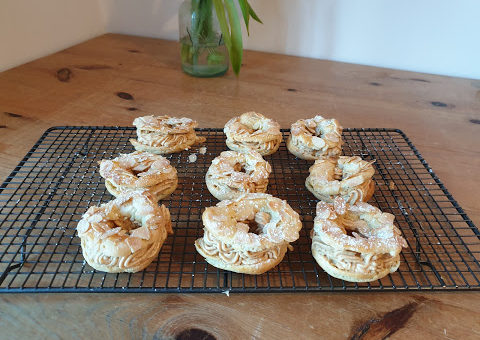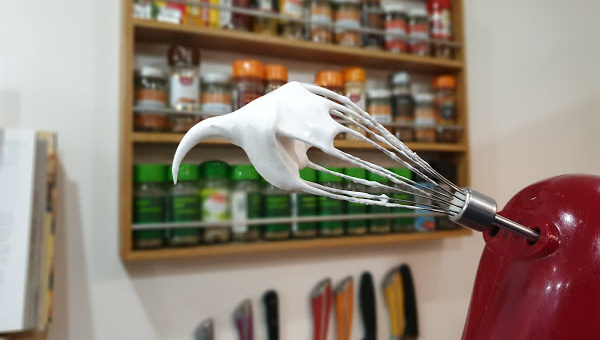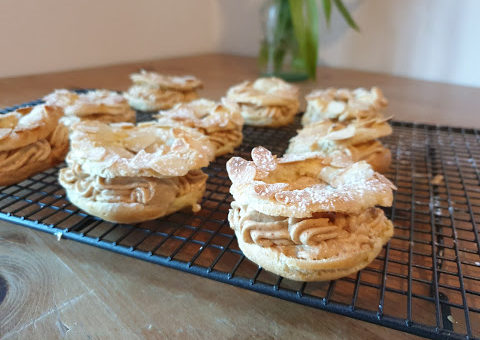The Taming of the Choux
Paris-Brest is a choux pastry dessert with a delicious praline flavoured filling, topped with flaked almonds. It was created in 1910 to commemorate the 1200km Paris-Brest-Paris cycle race. The race was organised to demonstrate the practicality of the bicycle, and the dessert’s circular shape represents a wheel. And Paris-Brest really does take you on a ride…
Baking
I have a soft spot for choux pastry. I consider it the cherry blossom of the baking world as it is so fleeting. Recipes will tell you it will store for a few days in the fridge, but the reality is that a filled choux bun is never the same after a day.
Paris-Brest really does bake your breath away. It involves making choux pastry rings and filling them with a praline mousseline cream. Even having made the praline in advance, it was still an incredibly time-consuming and elaborate process. Indeed, you could have cycled from Paris to Brest and back again in the time it takes to make the filling. The delicate, silky smooth mousseline cream is made by combining praline, crème au beurre and crème patissière. These separate elements are not quick, particularly as the crème au beurre alone involves two stages: making an Italian meringue and combining it with an egg yolk buttercream, both of which involve heating a sugar syrup. There are recipes with simpler visions, which involve mixing the crème patissière with praline and whipped butter, or omitting the crème patissière for a more straight forward, albeit dense cream. However, I decided to go the whole hog for this version and the taste did not disappoint.
Translation
Measure for measure
French recipes sometimes have a habit of specifying units of liquid in grams, instead of millilitres, as we would usually see in an English recipe. As the gram is a unit of weight and a millilitre a unit of volume, it’s useful to know the difference. Some chefs argue that weighing out the liquid is more accurate than using a measuring jug, which can vary depending on the angle of the baker. Fortunately water is the same in both grams and millilitres so I just changed the g to ml. The difference is actually minimal for other liquids used in baking, such as milk, single cream and double cream, especially for small quantities, but significantly greater for something like whipped cream. If in doubt this website is useful for calculating.
Crème au beurre
As previously explained, the mousseline filling calls for a crème au beurre, which involves making an Italian meringue (heating sugar and water and adding it to whisked egg whites), and then adding it to an egg yolk buttercream, which can either involve heating sugar and water over a pan and adding to whisked egg yolks, then mixing in the butter; or simply adding whipped butter to beaten egg yolks. The literal translation of crème au beurre is buttercream, which is significantly different to the British buttercream, which is made by combining butter, icing sugar and any relevant flavouring. For that reason, I decided to keep the French ‘crème au beurre’ to distinguish from the much simpler English buttercream.

Spaced out
When drawing out rings on which to pipe the choux pastry, the recipe instructs you to “disposer vos marques en quinconces”, literally: arrange your markings in quinconces. A quincunx, I discovered, is an arrangement of five items in a square with one in the middle. It is essentially a complicated way of asking you to space your circles far enough apart so the rings do not merge during baking, which is the translation I opted for to be clear and straight-forward.
Peak performance
When the Italian meringue is ready the recipe states that it should “former un bec d’oiseau”, literally: form a bird’s beak, referring to the meringue folding in slightly in on itself when the whisk is turned upside down. Confusingly, there seem to be lots of different opinions out there on what stage this is. Most of the recipes I researched for an Italian meringue whisked the egg whites to soft peaks, but plenty of definitions of ‘bird’s beak’ stage referred to egg whites which were whisked to medium or stiff peaks. The recipe also says the meringue should be “très ferme”, literally “very firm”. It seems we need peaks which are at very firm bird beak stage. So where does this leave us? Research into medium peaks and firm peaks both showed egg white shapes with the distinct bird’s beak I was after, so I decided that either of these would be appropriate. Stiff peaks would form a more upright shape, which is a later stage in the mixing process. I went with “medium peaks” in the end and explained that “when the whisked is turned upside down the tip should flop over forming a bird’s beak”. This website explains the different peaks clearly, and this one shows the bird’s beak when the whites are whisked to medium peaks.

Still on the subject of the Italian meringue, the recipe asks you to add the heated sugar and water to the whisked egg whites by [direct translation:] “‘gently pouring it onto the egg whites”. I took the liberty of offering a little more guidance to the baker as the sugar is usually poured in gently down the side of the bowl into the egg whites. I know first-hand that adding hot sugar directly onto the beater can stick to it, instantly solidifying and ruining the meringue. This may or may not be obvious to a French readership, but I’m confident that an English one would welcome any additional tips and tricks. After all, it’s disheartening and time-consuming falling prey to these kinds of mistakes so for the sake of the success of the recipe, and reputation of the author, it’s best if they can be avoided.
Conclusion
The result is something special and a perfect light snack. The only downside is the sheer effort. If I am offered the opportunity to complete a Paris-Brest in the future, I shall be picking up my bicycle and not my spatula. I would, however, leap at the chance to eat one.
See the recipe in French at http://www.lespetitesideesculinairesdechrisandco.com/2015/01/paris-brest-de-christophe-felder.html and an English translation of a larger version with a twist at https://www.patisseriemakesperfect.co.uk/paris-brest-giveaway/.



